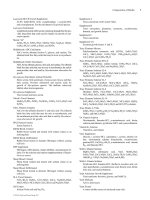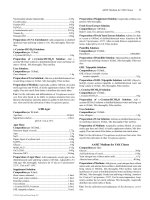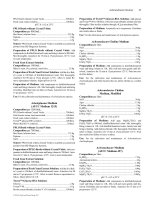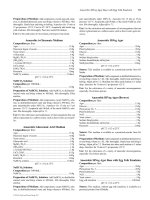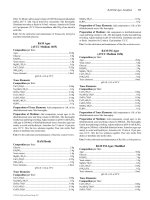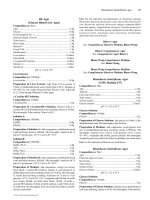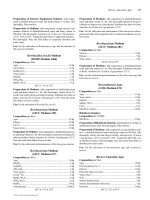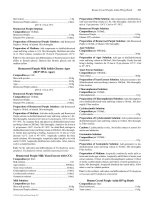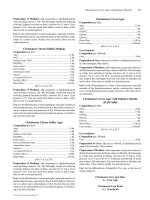Handbook of Microbiological Media, Fourth Edition part 3 pps
Bạn đang xem bản rút gọn của tài liệu. Xem và tải ngay bản đầy đủ của tài liệu tại đây (235.15 KB, 10 trang )
AAHC Medium for YAK Clones 15
Nicotinamide adenine dinucleotide 0.25g
Cocarboxylase 0.1g
Guanine·HCl 0.03g
Fe(NO
3
)
3
0.02g
p-Aminobenzoic acid 0.013g
Vitamin B
12
0.01g
Thiamine·HCl 3.0mg
Preparation of CVA Enrichment: Add components to distilled/
deionized water and bring volume to 1.0L. Mix thoroughly. Filter ster-
ilize.
L-Cysteine·HCl·H
2
O Solution:
Composition
per 10.0mL:
L-Cysteine·HCl·H
2
O 0.4g
Preparation of L-Cysteine·HCl·H
2
O Solution: Add L-
cysteine·HCl·H
2
O solution to distilled/deionized water and bring vol-
ume to 10.0mL. Mix thoroughly. Filter sterilize.
Urea Solution:
Composition
per 10.0mL:
Urea, ultrapure 1.0g
Preparation of Urea Solution: Add urea to distilled/deionized wa-
ter and bring volume to 10.0mL. Mix thoroughly. Filter sterilize.
Preparation of Medium: Aseptically combine 160.0mL of cooled,
sterile agar base and 45.9mL of sterile supplement solution. Mix thor-
oughly. Pour into sterile Petri dishes or distribute into sterile tubes.
Use: For the cultivation and differentiation of Ureaplasma urealyti-
cum from urine based on its ability to produce ammonia from urea.
Bacteria that produce ammonia appear as golden to dark brown colo-
nies. Also used for the cultivation of other Ureaplasma species.
A 8B Agar
Composition per 84.6mL:
Agar base 80.0mL
Supplement solution 4.6mL
pH 6.0 ± 0.2 at 25°C
Agar Base:
Composition
per 165.0mL:
Pancreatic digest of casein 2.72g
Agar 2.1g
NaCl 0.8g
Papaic digest of soybean meal 0.48g
K
2
HPO
4
0.4g
Glucose 0.4g
MnSO
4
·H
2
O 0.15g
CaCl
2
·2H
2
O 0.03g
Putrescine·2HCl 34.0mg
Preparation of Agar Base: Add components, except agar, to dis-
tilled/deionized water and bring volume to 165.0mL. Adjust pH to 5.5.
Add agar. Mix thoroughly. Autoclave for 15 min at 15 psi pressure–
121°C. Cool to 45°–50°C.
Supplement Solution:
Composition
per 4.6mL:
Horse serum, unheated 1.0mL
Fresh yeast extract solution 1.0mL
Penicillin solution 1.0mL
Urea solution 1.0mL
L-Cysteine·HCl·H
2
O solution 0.5mL
GHL tripeptide solution 0.1mL
Preparation of Supplement Solution: Aseptically combine com-
ponents. Mix thoroughly.
Fresh Yeast Extract Solution:
Composition
per 100.0mL:
Baker’s yeast, live, pressed, starch-free 25.0g
Preparation of Fresh Yeast Extract Solution: Add the live Bak-
er’s yeast to 100.0mL of distilled/deionized water. Autoclave for 90
min at 15 psi pressure–121°C. Allow to stand. Remove supernatant so-
lution. Adjust pH to 6.6–6.8. Filter sterilize.
Penicillin Solution:
Composition
per 10.0mL:
Penicillin G 1,000,000U
Preparation of Penicillin Solution: Add penicillin to distilled/de-
ionized water and bring volume to 10.0mL. Mix thoroughly. Filter ster-
ilize.
GHL Tripeptide Solution:
Composition per 10.0mL:
GHL (Glycyl-L-histidyl-L-lysine
acetate) tripeptide 0.2g
Preparation of GHL Tripeptide Solution: Add GHL (Glycyl-L-
histidyl-L-lysine acetate) tripeptide to distilled/deionized water and
bring volume to 10.0mL. Mix thoroughly. Filter sterilize.
L-Cysteine·HCl·H
2
O Solution:
Composition
per 10.0mL:
L-Cysteine·HCl·H
2
O 0.4g
Preparation of L-Cysteine·HCl·H
2
O Solution: Add L-
cysteine·HCl·H
2
O solution to distilled/deionized water and bring vol-
ume to 10.0mL. Mix thoroughly. Filter sterilize.
Urea Solution:
Composition
per 10.0mL:
Urea, ultrapure 1.0g
Preparation of Urea Solution: Add urea to distilled/deionized wa-
ter and bring volume to 10.0mL. Mix thoroughly. Filter sterilize.
Preparation of Medium: Aseptically combine 80.0mL of cooled,
sterile agar base and 4.6mL of sterile supplement solution. Mix thor-
oughly. Pour into sterile Petri dishes or distribute into sterile tubes.
Use: For the cultivation of Ureaplasma urealyticum from urine. Also
used for the cultivation of other Ureaplasma species.
AAHC Medium for YAK Clones
Composition per liter:
Glucose 20.0g
Acid hydrolysate of casein 10.0g
Yeast nitrogen base without amino acids 6.7g
Adenine hemi-sulfate 40.0mg
Preparation of Medium: Add glucose, yeast nitrogen base without
amino acids, and adenine hemi-sulfate to distilled/deionized water and
bring volume to 100.0mL. Mix thoroughly. Filter sterilize. Add acid
hydrolysate of casein to distilled/deionized water and bring volume to
900.0mL. Mix thoroughly. Gently heat and bring to boiling. Autoclave
for 15 min at 15 psi pressure–121°C. Cool to room temperature. Asep-
tically combine the two sterile solutions. Mix thoroughly. Aseptically
distribute into sterile tubes or flasks.
Use: For the cultivation and maintenance of Saccharomyces cerevi-
siae.
© 2010 by Taylor and Francis Group, LLC
16 AAM Medium
AAM Medium
(DSMZ Medium 57)
Composition per liter:
Casamino acids 7.0g
Yeast extract 7.0g
Tryptone 5.0g
Meat extract 5.0g
Na-acetate 2.5g
MgSO
4
·7H
2
O 200.0mg
MnSO
4
·2H
2
O 50.0mg
Tween™ 80 1.0mL
pH 5.4 ± 0.2 at 25°C
Preparation of Medium: Add components to distilled/deionized
water and bring volume to 1.0L. Mix thoroughly. Adjust pH to 5.4.
Distribute into tubes or flasks. Autoclave for 15 min at 15 psi pressure–
121°C.
Use: For the cultivation and maintenance of Lactobacillus spp.
AATCC Bacteriostasis Agar
(American Association of
Textile Chemists and Colorists
Bacteriostasis Agar)
Composition per liter:
Agar 15.0g
Peptone 10.0g
Beef extract 5.0g
NaCl 5.0g
pH 7.2 ± 0.2 at 25°C
Preparation of Medium: Add components to distilled/deionized
water and bring volume to 1.0L. Mix thoroughly. Gently heat and bring
to boiling. Autoclave for 15 min at 15 psi pressure–121°C. Pour into
sterile Petri dishes or distribute into sterile tubes.
Use: For the maintenance of cultures of Escherichia coli and Staphy-
lococcus aureus. For the detection of antibacterial activity of fabrics.
Test cultures of Escherichia coli or Staphylococcus aureus are inocu-
lated onto an agar plate and a sample of sterile fabric is placed on the
surface. Lack of bacterial growth indicates the fabric has antibacterial
activity.
AATCC Bacteriostasis Agar
See: FDA Agar
AATCC Bacteriostasis Broth
See: FDA Broth
AATCC Bacteriostasis HiVeg Agar
Composition per liter:
Agar 15.0g
Plant peptone 10.0g
Plant extract 5.0g
NaCl 5.0g
pH 7.2 ± 0.2 at 25°C
Source: This medium is available as a premixed powder from Hi-
Media.
Preparation of Medium: Add components to distilled/deionized
water and bring volume to 1.0L. Mix thoroughly. Gently heat and bring
to boiling. Autoclave for 15 min at 15 psi pressure–121°C. Pour into
sterile Petri dishes or distribute into sterile tubes.
Use: For for the detection of antibacterial activity of fabrics.
AATCC Bacteriostasis HiVeg Broth
Composition per liter:
Plant peptone 10.0g
Plant extract 5.0g
NaCl 5.0g
pH 6.8 ± 0.2 at 25°C
Source: This medium is available as a premixed powder from Hi-
Media.
Preparation of Medium: Add components to distilled/deionized
water and bring volume to 1.0L. Mix thoroughly. Gently heat and bring
to boiling. Distribute into tubes or flasks. Autoclave for 15 min at 15
psi pressure–121°C.
Use: For for the detection of antibacterial testing of antiseptics and
disinfectants.
AATCC Mineral Salts Iron Agar
(American Association of
Textile Chemists and Colorists
Mineral Salts Iron Agar)
Composition per liter:
Agar 20.0g
(NH
4
)
2
NO
3
3.0g
KH
2
PO
4
2.5g
K
2
HPO
4
2.0g
MgSO
4
·7H
2
O 0.2g
FeSO
4
·7H
2
O 0.1g
pH 5.6 ± 0.2 at 25°C
Preparation of Medium: Add components to distilled/deionized
water and bring volume to 1.0L. Mix thoroughly. Gently heat and bring
to boiling. Distribute into tubes or flasks. Autoclave for 15 min at 15
psi pressure–121°C.
Use: For testing the resistance of textiles to fungi that cause mildew
and rot. Also used to test the effectiveness of fungicides used on tex-
tiles for preventing the growth of fungi. Cultures of Chaetomium glo-
bosum or Aspergillus niger are inoculated onto the plate and a sample
of fabric is placed on top. Lack of growth of these fungi on the textile
is indicative of resistance to mildew.
Abeyta-Hunt Bark Agar
Composition per 1016.0mL:
Beef heart, infusion from 500.0g
Agar 15.0g
Tryptose 10.0g
NaCl 5.0g
Yeast extract 2.0g
Horse blood, lysed 50.0mL
Cefoperazone solution 4.0mL
Rifampicin solution 4.0mL
Amphotericin B solution 4.0mL
Ferrous sulfate pyruvate
metabisulfite solution 4.0mL
pH 7.4 ± 0.2 at 25°C
© 2010 by Taylor and Francis Group, LLC
AC HiVeg Agar 17
Amphotericin B Solution:
Composition
per 100.0mL:
Amphotericin B 0.05g
Preparation of Amphotericin B Solution: Add amphotericin B
to distilled/deionized water and bring volume to 100.0mL. Mix thor-
oughly. Filter sterilize.
Cefoperazone Solution:
Composition
per 100.0mL:
Sodium cefoperazone 0.08g
Preparation of Cefoperazone Solution: Add sodium cefopera-
zone to distilled/deionized water and bring volume to 100.0mL. Mix
thoroughly. Filter sterilize.
Rifampicin Solution:
Composition
per 100.0mL
Rifampicin 0.25g
Preparation of Rifampicin Solution: Add rifampicin to 70.0mL
ethanol. Mix thoroughly. Add distilled/deionized water to bring vol-
ume to 100.0mL. Mix thoroughly. Filter sterilize.
Ferrous Sulfate, Pyruvate, Metabisulfite Solution:
Composition
per 100.0mL:
FeSO
4
6.25g
Na-pyruvate 6.25g
Na-metabisulfite 6.25g
Preparation of Ferrous Sulfate, Pyruvate, Metabisulfite So-
lution:
Add Na-pyruvate to 20mL distilled/deionized water. Mix thor-
oughly. Add Na-metabisulfite and FeSO
4
. Bring volume to 100.0mL.
Mix thoroughly. Filter sterilize.
Preparation of Medium: Add components, except cefoperazone
solution, amphotericin B solution, rifampicin solution, ferrous sulfate
pyruvate metabisulfide solution, and horse blood, to distilled/deionized
water and bring volume to 950.0mL. Mix thoroughly. Gently heat and
bring to boiling. Autoclave for 15 min at 15 psi pressure–121°C. Cool
to 50°C. Aseptically add 4.0mL cefoperazone solution, 4.0mL ampho-
tericin B solution, 4.0mL rifampicin solution, 4.0mL ferrous sulfate
pyruvate metabisulfide solution, and 50.0mL lysed horse blood. Mix
thoroughly. Pour into sterile Petri dishes or distribute into sterile tubes.
Use: For the isolation and cultivation of Campylobacter spp.
ABY Agar
(Acid Bismuth Yeast Agar)
Composition per liter:
Agar 20.0g
Glucose 20.0g
Bi
2
(SO
3
)
2
8.0g
(NH
4
)
2
SO
4
3.0g
KH
2
PO
4
3.0g
MgSO
4
·7H
2
O 0.25g
CaCl
2
·2H
2
O 0.25g
Biotin 10.0μg
pH 7.2 ± 0.2 at 25°C
Preparation of Medium: Add components to distilled/deionized
water and bring volume to 1.0L. Mix thoroughly. Gently heat and bring
to boiling. Distribute into tubes or flasks. Autoclave for 15 min at 15
psi pressure–121°C. Cool tubes in a slanted position.
Use: For the selective isolation and differentiation of Candida albi-
cans from other Candida species. Candida albicans and Candida trop-
icalis colonies appear as smooth, brownish-black round colonies.
Other Candida species are differentially pigmented or produce diffus-
ible pigments. Usually used in conjunction with BiGGY agar to differ-
entiate further Candida; on BiGGY agar, Candida albicans appears as
brown to black colonies with no pigment diffusion and no sheen,
whereas Candida tropicalis appears as dark brown colonies with black
centers, black pigment diffusion, and a sheen.
AC Agar
(AC Medium)
Composition per liter:
Proteose peptone No. 3 20.0g
Glucose 5.0g
Beef extract 3.0g
Yeast extract 3.0g
Malt extract 3.0g
Ascorbic acid 0.2g
Agar 1.0g
pH 7.2 ± 0.2 at 25°C
Source: This medium is available as a premixed powder from BD Di-
agnostic Systems.
Preparation of Medium: Add components to distilled/deionized
water and bring volume to 1.0L. Mix thoroughly. Gently heat and bring
to boiling. Distribute into tubes or flasks. Autoclave for 15 min at 15
psi pressure–121°C.
Use: For the cultivation and isolation of anaerobes, microaerophiles,
and aerobes. Recommended for the sterility testing of solutions and
other materials not containing mercurial preservatives.
AC Broth
Composition per liter:
Proteose peptone No. 3 20.0g
Glucose 5.0g
Beef extract 3.0g
Yeast extract 3.0g
Malt extract 3.0g
Ascorbic acid 0.2g
pH 7.2 ± 0.2 at 25°C
Source: This medium is available as a premixed powder from BD Di-
agnostic Systems.
Preparation of Medium: Add components to distilled/deionized
water and bring volume to 1.0L. Mix thoroughly. Gently heat and bring
to boiling. Distribute into tubes or flasks. Autoclave for 15 min at 15
psi pressure–121°C.
Use: For the cultivation and isolation of a wide variety of microorgan-
isms, including anaerobes, microaerophiles, and aerobes. Recom-
mended for the sterility testing of solutions and other materials not con-
taining mercurial preservatives.
AC HiVeg Agar
Composition per liter:
Plant peptone No. 3 20.0g
Glucose 5.0g
Plant extract 3.0g
Yeast extract 3.0g
Malt extract 3.0g
Ascorbic acid 0.2g
Agar 1.0g
pH 7.2 ± 0.2 at 25°C
© 2010 by Taylor and Francis Group, LLC
18 AC HiVeg Broth
Source: This medium is available as a premixed powder from Hi-
Media.
Preparation of Medium: Add components to distilled/deionized
water and bring volume to 1.0L. Mix thoroughly. Gently heat and bring
to boiling. Distribute into tubes or flasks or bottles. Autoclave for 15
min at 15 psi pressure–121°C.
Use: For the cultivation and isolation of anaerobes, microaerophiles,
and aerobes. Recommended for the sterility testing of solutions and
other materials not containing mercurial preservatives.
AC HiVeg Broth
Composition per liter:
Plant peptone No. 3 20.0g
Glucose 5.0g
Plant extract 3.0g
Yeast extract 3.0g
Malt extract 3.0g
Ascorbic acid 0.2g
pH 7.2 ± 0.2 at 25°C
Source: This medium is available as a premixed powder from Hi-
Media.
Preparation of Medium: Add components to distilled/deionized
water and bring volume to 1.0L. Mix thoroughly. Gently heat and bring
to boiling. Distribute into tubes or flasks. Autoclave for 15 min at 15
psi pressure–121°C.
Use: For the cultivation and isolation of a wide variety of microorgan-
isms, including anaerobes, microaerophiles, and aerobes. Recom-
mended for the sterility testing of solutions and other materials not con-
taining mercurial preservatives.
AC Medium
See: AC Agar
Acanthamoeba Medium
Composition per liter:
Proteose peptone 15.0g
Glucose 15.0g
KH
2
PO
4
0.3g
L-Methionine 14.9mg
Thiamine 1.0mg
Biotin 0.2mg
Vitamin B
12
1.0μg
Salt solution 1.0mL
pH 5.5 ± 0.2 at 25°C
Salt Solution:
Composition
per 100.0mL:
MgSO
4
·7H
2
O 2.46g
CaCl
2
·2H
2
O 0.15g
FeCl
3
0.02g
Preparation of Salt Solution: Add components to distilled/deion-
ized water and bring volume to 100.0mL. Mix thoroughly.
Preparation of Medium: Add components to distilled/deionized
water and bring volume to 1.0L. Mix thoroughly. Adjust pH to 5.5. Fil-
ter through Whatman paper to remove particles. Distribute into screw-
capped tubes or flasks. Autoclave for 15 min at 15 psi pressure–121°C.
Use: For the cultivation of Acanthamoeba species.
ACB90 Medium
(DSMZ Medium 298h)
Composition per liter:
NaCl 1.0g
KCl 0.5g
MgCl
2
·6H
2
O 0.4g
NH
4
Cl 0.25g
KH
2
PO
4
0.2g
CaCl
2
·2H
2
O 0.15g
Resazurin 1.0mg
NaHCO
3
solution 10.0mL
Butanediol solution 10.0mL
Na
2
S·9H
2
O solution 10.0mL
Vitamin solution 10.0mL
Seven vitamin solution 10.0mL
Glucose solution 10.0mL
Trace elements solution SL-10 1.0mL
pH 7.2 ± 0.2 at 25°C
Na
2
S·9H
2
O Solution:
Composition per 10.0mL:
Na
2
S·9H
2
O 0.36g
Preparation of Na
2
S·9H
2
O Solution: Add Na
2
S·9H
2
O to dis-
tilled/deionized water and bring volume to 10.0mL. Mix thoroughly.
Autoclave under 100% N
2
for 15 min at 15 psi pressure–121°C. Cool
to room temperature.
NaHCO
3
Solution:
Composition
per 10.0mL:
NaHCO
3
2.5g
Preparation of NaHCO
3
Solution: Add NaHCO
3
to distilled/de-
ionized water and bring volume to 10.0mL. Mix thoroughly. Sparge
with 80% N
2
+ 20% CO
2
. Filter sterilize.
Butanediol Solution:
Composition
per 10.0mL:
2,3 butanediol 0.9g
Preparation of Butanediol Solution: Add butanediol to distilled/
deionized water and bring volume to 10.0mL. Mix thoroughly. Sparge
with 100% N
2
. Filter sterilize.
Trace Elements Solution SL-10:
Composition
per liter:
FeCl
2
·4H
2
O 1.5g
CoCl
2
·6H
2
O 190.0mg
MnCl
2
·4H
2
O 100.0mg
ZnCl
2
70.0mg
Na
2
MoO
4
·2H
2
O 36.0mg
NiCl
2
·6H
2
O 24.0mg
H
3
BO
3
6.0mg
CuCl
2
·2H
2
O 2.0mg
HCl (25% solution) 10.0mL
Preparation of Trace Elements Solution SL-10: Add FeCl
2
·4H
2
O
to 10.0mL of HCl solution. Mix thoroughly. Add distilled/deionized
water and bring volume to 1.0L. Add remaining components. Mix thor-
oughly. Sparge with 80% N
2
+ 20% CO
2
. Autoclave for 15 min at 15
psi pressure–121°C.
Vitamin Solution:
Composition
per liter:
Pyridoxine-HCl 10.0mg
Thiamine-HCl·2H
2
O 5.0mg
Riboflavin 5.0mg
© 2010 by Taylor and Francis Group, LLC
ACE Medium 19
Nicotinic acid 5.0mg
D-Ca-pantothenate 5.0mg
p-Aminobenzoic acid 5.0mg
Lipoic acid 5.0mg
Biotin 2.0mg
Folic acid 2.0mg
Vitamin B
12
0.1mg
Preparation of Vitamin Solution: Add components to distilled/
deionized water and bring volume to 1.0L. Mix thoroughly. Sparge
with 80% H
2
+ 20% CO
2
. Filter sterilize.
Seven Vitamin Solution:
Composition
per liter:
Pyridoxine hydrochloride 300.0mg
Thiamine-HCl·2H
2
O 200.0mg
Nicotinic acid 200.0mg
Vitamin B
12
100.0mg
Calcium pantothenate 100.0mg
p-Aminobenzoic acid 80.0mg
D(+)-Biotin 20.0mg
Preparation of Seven Vitamin Solution: Add components to dis-
tilled/deionized water and bring volume to 1.0L. Sparge with 100% N
2
.
Mix thoroughly. Filter sterilize.
Cellobiose Solution:
Composition
per 10.0mL:
Cellobiose 0.7g
Preparation of Cellobiose Solution: Add cellobiose to distilled/
deionized water and bring volume to 10.0mL. Mix thoroughly. Sparge
with 100% N
2
. Filter sterilize.
Preparation of Medium: Prepare and dispense medium under 80%
N
2
+ 20% CO
2
gas atmosphere. Add components, except NaHCO
3
solu-
tion, butanediol solution, Na
2
S·9H
2
O solution, vitamin solution, seven
vitamin solution, cellobiose solution, and trace elements solution SL-
10, to distilled/deionized water and bring volume to 939.0mL. Mix thor-
oughly. Adjust pH to 7.2. Sparge with 80% N
2
+ 20% CO
2
. Autoclave
for 15 min at 15 psi pressure–121°C. Aseptically and anaerobically add
10.0mL NaHCO
3
solution, 10.0mL butanediol solution, 10.0mL
Na
2
S·9H
2
O solution, 10.0mL vitamin solution, 10.0mL seven vitamin
solution, 10.0mL cellobiose solution, and 1.0mL trace elements solu-
tion SL-10. Mix thoroughly. Aseptically and anaerobically distribute
into sterile tubes or bottles. After inoculation, flush and repressurize the
gas head space of culture bottles with sterile 80% N
2
+ 20% CO
2
to 1
bar overpressure.
Use: For the cultivation of an unclassified bacterium (Brevigemma cel-
lulytica) DSM 11249.
ACC Medium
Composition per liter:
Proteose peptone 20.0g
Agar 12.0g
Glycerol 1.5g
K
2
SO
4
1.5g
MgSO
4
·7H
2
O 1.5g
Antibiotic solution 10.0mL
pH 7.2 ± 0.2 at 25°C.
Antibiotic Solution:
Composition
per 10.0mL:
Cycloheximide 0.075g
Ampicillin 0.05g
Chloramphenicol 0.0125g
Preparation of Antibiotic Solution: Add components to distilled/
deionized water and bring volume to 10.0mL. Mix thoroughly. Filter
sterilize.
Caution: Cycloheximide is toxic. Avoid skin contact or aerosol for-
mation and inhalation.
Preparation of Medium: Add components, except antibiotic solu-
tion, to distilled/deionized water and bring volume to 990.0mL. Mix thor-
oughly. Gently heat and bring to boiling. Autoclave for 15 min at 15 psi
pressure–121°C. Cool to 45°–50°C. Aseptically add sterile antibiotic solu-
tion. Mix thoroughly. Pour into sterile Petri dishes or distribute into sterile
tubes.
Use: For the selective isolation and cultivation of fluorescent Pseudo-
monas species.
ACE Medium
Composition per liter:
NaCl 18.0g
MgCl
2
·6H
2
O 6.0g
NaHCO
3
2.0g
MgSO
4
·7H
2
O 1.0g
Yeast extract 1.0g
L-Cysteine·HCl 0.5g
KCl 0.335g
NH
4
Cl 0.25g
CaCl
2
·2H
2
O 0.14g
K
2
HPO
4
0.14g
Fe(NH
4
)
2
(SO
4
)
2
·6H
2
O 2.0mg
Resazurin 1.0mg
Glucose solution 20.0mL
Wolfe’s vitamin solution 10.0mL
pH 7.6 ± 0.2 at 25°C
Glucose Solution:
Composition
per 50.0mL:
D-Glucose 10.0g
Preparation of Glucose Solution: Add glucose to distilled/deion-
ized water and bring volume to 50.0mL. Mix thoroughly. Sparge with
100% N
2
. Autoclave for 15 min at 15 psi pressure–121°C.
Wolfe’s Vitamin Solution:
Composition
per liter:
Pyridoxine·HCl 10.0mg
p-Aminobenzoic acid 5.0mg
Lipoic acid 5.0mg
Nicotinic acid 5.0mg
Riboflavin 5.0mg
Thiamine·HCl 5.0mg
Calcium
DL-pantothenate 5.0mg
Biotin 2.0mg
Folic acid 2.0mg
Vitamin B
12
0.1mg
Preparation of Wolfe’s Vitamin Solution: Add components to
distilled/deionized water and bring volume to 1.0L. Mix thoroughly.
Filter sterilize.
Preparation of Medium: Add components, except L-cysteine·HCl,
NaHCO
3
, and glucose solution, to distilled/deionized water and bring
volume to 980.0mL. Mix thoroughly. Adjust pH to 7.6. Gently heat and
bring to boiling. Continue boiling for 3 min. Cool to room temperature
while sparging with O
2
-free 100% N
2
. Add L-cysteine·HCl and
NaHCO
3.
Anaerobically distribute 9.8mL volumes into anaerobic
© 2010 by Taylor and Francis Group, LLC
20 Acetamide Agar
tubes. Autoclave for 15 min at 15 psi pressure–121°C. Aseptically and
anaerobically add 0.2mL of sterile glucose solution to each tube. Mix
thoroughly.
Use: For the cultivation of unclassified bacterium DSM 6211 and
unclassified bacterium DSM 6226.
Acetamide Agar
Composition per liter:
Agar 15.0g
Acetamide 10.0g
NaCl 5.0g
K
2
HPO
4
1.0g
NH
4
H
2
PO
4
1.0g
MgSO
4
·7H
2
O 0.2g
Bromthymol Blue 0.08g
pH 6.9 ± 0.2 at 25°C
Preparation of Medium: Add components to distilled/deionized
water and bring volume to 1.0L. Mix thoroughly. Gently heat and bring
to boiling. Adjust pH. Distribute into tubes or flasks. Autoclave for 15
min at 15 psi pressure–121°C. Cool tubes in a slanted position to pro-
duce a long slant.
Use: For the differentiation of nonfermentative Gram-negative bacte-
ria, especially Pseudomonas aeruginosa. Can be used as a confirma-
tory test for water analysis. Bacteria that deamidate acetamide turn the
medium blue.
Acetamide Agar
Composition per liter:
Agar 15.0g
Acetamide 10.0g
NaCl 5.0g
K
2
HPO
4
1.39g
KH
2
PO
4
0.73g
MgSO
4
·7H
2
O 0.5g
Phenol Red 0.012g
pH 6.9 ± 0.2 at 25°C
Source: This medium is available as a premixed powder from BD Di-
agnostic Systems.
Preparation of Medium: Add components to distilled/deionized
water and bring volume to 1.0L. Mix thoroughly. Gently heat and bring
to boiling. Adjust pH. Distribute into tubes or flasks. Autoclave for 15
min at 15 psi pressure–121°C. Cool tubes in a slanted position to pro-
duce a long slant.
Use: For the differentiation of nonfermentative Gram-negative bacte-
ria, especially Pseudomonas aeruginosa. Can be used as a confirma-
tory test for water analysis. Bacteria that deamidate acetamide turn the
medium red.
Acetamide Broth
Composition per liter:
Acetamide 10.0g
NaCl 5.0g
K
2
HPO
4
1.39g
KH
2
PO
4
0.73g
MgSO
4
·7H
2
O 0.5g
Phenol Red 0.012g
pH 6.9 ± 0.2 at 25°C
Preparation of Medium: Add components to distilled/deionized
water and bring volume to 1.0L. Mix thoroughly. Adjust pH. Autoclave
for 15 min at 15 psi pressure–121°C.
Use: For the differentiation of nonfermentative Gram-negative bacte-
ria, especially Pseudomonas aeruginosa. Can be used as a confirma-
tory test for water analysis. Bacteria that deamidate acetamide turn the
broth purplish red.
Acetamide Broth
Composition per liter:
Acetamide 2.0g
KH
2
PO
4
1.0g
NaCl 0.2g
MgSO
4
, anhydrous 0.2g
Na
2
MoO
4
·2H
2
O 5.0mg
FeSO
4
0.5mg
pH 7.0 ± 0.2 at 25°C
Source: This medium is available from HiMedia.
Preparation of Medium: Add components, except acetamide, to
distilled/deionized water and bring volume to 1.0L. Mix thoroughly.
Add acetamide. Adjust pH to 7.0. Autoclave for 15 min at 15 psi pres-
sure–121°C.
Use: For the differentiation of nonfermentative Gram-negative bacte-
ria, especially Pseudomonas aeruginosa.
Acetamide Cetrimide Glycerol
Mannitol Selective Medium
Composition per liter:
Agar 15.0g
K
2
SO
4
10.0g
D-Mannitol 5.0g
MgCl
2
·6H
2
O 1.4g
Cetrimide 0.3g
Peptone 0.2g
Acetamide solution 100.0mL
Glycerol 5.0mL
pH 7.0 ± 0.2 at 25°C
Acetamide Solution:
Composition
per 100.0mL:
Acetamide 10.0g
Phenol Red 0.012g
Preparation of Acetamide Solution: Add components to dis-
tilled/deionized water and bring volume to 100.0mL. Mix thoroughly.
Filter sterilize.
Preparation of Medium: Add components, except acetamide solu-
tion, to distilled/deionized water and bring volume to 900.0mL. Mix
thoroughly. Adjust pH to 7.0. Gently heat and bring to boiling. Auto-
clave for 20 min at 15 psi pressure–121°C. Cool to 45°–50°C. Asepti-
cally add sterile acetamide solution. Mix thoroughly. Pour into sterile
Petri dishes.
Use: For the cultivation of Pseudomonas aeruginosa, Pseudomonas
fluorescens, Pseudomonas putida, Pseudomonas alcaligenes,
Pseudomonas cepacia, and Pseudomonas pseudoalcaligenes.
Acetamide Medium
Composition per liter:
Agar, noble 20.0g
Glucose 20.0g
© 2010 by Taylor and Francis Group, LLC
Acetate Agar 21
KH
2
PO
4
15.0g
CsC1
2
solution 12.5mL
Acetamide solution 10.0mL
CaCl
2
·2H
2
O solution 4.1mL
MgSO
4
·7H
2
O solution 2.4mL
Trace elements solution 1.0mL
CsCl
2
Solution:
Composition
per 100.0mL:
CsC1
2
16.84g
Preparation of CsCl
2
Solution: Add CsC1
2
to distilled/deionized
water and bring volume to 100.0mL. Mix thoroughly. Autoclave for 15
min at 15 psi pressure–121°C.
Acetamide Solution:
Composition
per 100.0mL:
Acetamide 5.91g
Preparation of Acetamide Solution: Add acetamide to distilled/
deionized water and bring volume to 100.0mL. Mix thoroughly. Auto-
clave for 15 min at 15 psi pressure–121°C.
CaCl
2
·2H
2
O Solution:
Composition
per 100.0mL:
CaCl
2
·2H
2
O 14.7g
Preparation of CaCl
2
·2H
2
O Solution: Add CaCl
2
·2H
2
O to dis-
tilled/deionized water and bring volume to 100.0mL. Mix thoroughly.
Autoclave for 15 min at 15 psi pressure–121°C.
MgSO
4
·7H
2
O Solution:
Composition
per 100.0mL:
MgSO
4
·7H
2
O 24.65g
Preparation of MgSO
4
·7H
2
O Solution: Add MgSO
4
·7H
2
O to
distilled/deionized water and bring volume to 100.0mL. Mix thorough-
ly. Autoclave for 15 min at 15 psi pressure–121°C.
Trace Elements Solution:
Composition
per liter:
FeSO
4
·7H
2
O 5.0g
CoCl
2
·6H
2
O 3.7g
MnSO
4
·1H
2
O 1.6g
ZnSO
4
·7H
2
O 1.4g
Preparation of Trace Elements Solution: Add components to
distilled/deionized water and bring volume to 1.0L. Mix thoroughly.
Preparation of Medium: Add components, except CsC1
2
solution,
acetamide solution, CaCl
2
·2H
2
O solution, and MgSO
4
·7H
2
O solution,
to distilled/deionized water and bring volume to 971.0mL. Mix thor-
oughly. Gently heat and bring to boiling. Autoclave for 15 min at 15 psi
pressure–121°C. Cool to 50°–55°C. Aseptically add 12.5mL of sterile
CsC1
2
solution, 10.0mL of sterile acetamide solution, 4.1mL of sterile
CaCl
2
·2H
2
O solution, and 2.4mL of sterile MgSO
4
·7H
2
O solution. Mix
thoroughly. Pour into sterile Petri dishes or distribute into sterile tubes.
Use: For the cultivation and maintenance of Trichoderma longibra-
chiatum.
Acetamide Medium
(BAM M2)
Composition per liter:
Stock basal solution 400.0mL
Stock acetamide solution 100.0mL
pH 6.9 ± 0.2 at 25°C
Stock Basal Solution:
Composition
per 400.0mL:
Agar 0.5g
KH
2
PO
4
solution, 0.5M 14.0mL
K
2
HPO
4
solution, 0.5M 6.0mL
PR-CV solution 1.0mL
Preparation of Stock Basal Solution: Add components, except
PR-CV solution, to distilled/deionized water and bring volume to
400.0mL. Mix thoroughly. Gently heat and bring to boiling with agita-
tion to dissolve agar. Add 1.0mL PR-CV solution.
PR-CV Solution:
Composition
per 200.0mL:
Phenol Red 2.0g
Crystal Violet 0.2g
Preparation of PR-CV Solution: Add components to distilled/de-
ionized water and bring volume to 200.0mL. Mix thoroughly. Add 5N
NaOH while stirring until components are dissolved.
Stock Acetamide Solution:
Composition
per 100.0mL:
Acetamide 1.0g
Preparation of Stock Acetamide Solution: Add acetamide to
distilled/deionized water and bring volume to 100.0mL. Mix thorough-
ly. Store over methylene chloride in a screw-capped container. Can be
stored indefinitely at room temperature.
Preparation of Medium: Combine 400.0mL stock basal solution
and 100.0mL stock acetamide solution. Mix thoroughly. Distribute into
tubes or flasks. Steam for 10 min at 100°C. Cool.
Use: For the differentiation of nonfermentative Gram-negative bact-
eria, especially Pseudomonas aeruginosa, e.g., in milk.
Acetamide Nutrient Broth
Composition per liter:
Acetamide 2.0g
KH
2
PO
4
1.0g
NaCl 0.2g
MgSO
4
, anhydrous 0.158g
Na
2
MoO
4
·2H
2
O 5.0mg
FeSO
4
0.5mg
pH 7.0 ± 0.2 at 25°C
Source: This medium is available from HiMedia.
Preparation of Medium: Add components, except acetamide, to
distilled/deionized water and bring volume to 1.0L. Mix thoroughly.
Add acetamide. Adjust pH to 7.0. Autoclave for 15 min at 15 psi pres-
sure–121°C.
Use: For the differentiation of nonfermentative Gram-negative bact-
eria, especially Pseudomonas aeruginosa.
Acetate Agar
Composition per liter:
Agar 20.0g
Glucose 10.0g
Peptic digest of animal tissue 5.0g
Meat extract 5.0g
Yeast extract 5.0g
Sodium acetate 27.22g
Tween™ 80 0.5mL
pH 5.4 ± 0.2 at 25°C
© 2010 by Taylor and Francis Group, LLC
22 Acetate Agar
Source: This medium is available from HiMedia.
Preparation of Medium: Add components to distilled/deionized
water and bring volume to 900.0mL. Mix thoroughly. Gently heat and
bring to boiling. Adjust pH to 5.4. Distribute into tubes or flasks. Au-
toclave for 15 min at 15 psi pressure–121°C. Pour into Petri dishes or
leave in tubes.
Use: For the isolation and cultivation of Leuconostoc species and
Pediococcus species.
Acetate Agar
Composition per liter:
Meat extract 50.0g
Glucose 10.0g
Peptone 5.0g
Yeast extract 5.0g
Sodium acetate buffer 100.0mL
Tween™ 80 0.5mL
pH 5.4 ± 0.2 at 25°C
Sodium Acetate Buffer:
Composition
per liter:
Sodium acetate·3H
2
O 272.2g
Preparation of Sodium Acetate Buffer: Add sodium acetate to
distilled/deionized water and bring volume to 1.0L. Mix thoroughly.
Adjust pH to 5.4 with glacial acetic acid. Filter sterilize.
Preparation of Medium: Add components, except sodium acetate
buffer, to distilled/deionized water and bring volume to 900.0mL. Mix
thoroughly. Gently heat and bring to boiling. Adjust pH to 5.4. Auto-
clave for 15 min at 15 psi pressure–121°C. Cool to 45°–50°C. Aseptic-
ally add 100.0mL of sterile sodium acetate buffer. Mix thoroughly.
Aseptically distribute into sterile tubes or flasks.
Use: For the isolation and cultivation of Leuconostoc species and
Pediococcus species.
Acetate Agar
Composition per liter:
Agar 15.0g
Yeast extract 2.0g
Sodium acetate 1.0g
Pancreatic digest of casein 1.0g
pH 7.4 ± 0.2 at 25°C
Preparation of Medium: Add components to distilled/deionized
water and bring volume to 1.0L. Mix thoroughly. Gently heat and bring
to boiling. Distribute into tubes or flasks. Autoclave for 15 min at 15
psi pressure–121°C. Pour into sterile Petri dishes or leave in tubes.
Use: For the cultivation and maintenance of Caryophanon latum.
Acetate Agar
(BAM M3)
Composition per liter:
Agar 20.0g
NaCl 5.0g
Sodium acetate 2.0g
KH
2
PO
4
1.0g
(NH
4
)
2
PO
4
1.0g
MgSO
4
0.2g
Bromthymol Blue 0.08g
pH 6.7 ± 0.2 at 25°C
Preparation of Medium: Add components, except MgSO
4
, to dis-
tilled/deionized water and bring volume to 1.0L. Mix thoroughly. Gen-
tly heat and bring to boiling. Adjust pH to 6.7. Add 0.2g MgSO
4
. Mix
thoroughly. Autoclave for 15 min at 15 psi pressure–121°C. Cool to
45°–50°C. Aseptically distribute into tubes or flasks. For slants distrib-
ute aliquots into tubes prior to autoclaving. After autoclaving allow
tubes to cool in inclined position to obtain a 5cm slant.
Use: For the cultivation of Leuconostoc species.
Acetate Differential Agar
(Sodium Acetate Agar)
(Simmons’ Citrate Agar, Modified)
Composition per liter:
Agar 20.0g
NaCl 5.0g
Sodium acetate 2.0g
(NH
4
)H
2
PO
4
1.0g
K
2
HPO
4
1.0g
MgSO
4
·7H
2
O 0.2g
Bromthymol Blue 0.08g
pH 6.8 ± 0.2 at 25°C
Source: This medium is available as a premixed powder from BD Di-
agnostic Systems.
Preparation of Medium: Add components to cold distilled/deion-
ized water and bring volume to 1.0L. Mix thoroughly. Gently heat and
bring to boiling. Distribute into tubes to produce a 1 cm butt and 30 cm
slant. Autoclave for 15 min at 15 psi pressure–121°C. Cool tubes in a
slanted position.
Use: For the differentiation of Shigella species from Escherichia coli
and also for the differentiation of nonfermenting Gram-negative bacte-
ria. Bacteria that can utilize acetate as the sole carbon source turn the
medium blue.
Acetate HiVeg Agar
Composition per liter:
Sodium acetate·3H
2
O 27.22g
Agar 20.0g
Glucose 10.0g
Yeast extract 5.0g
Plant peptone 5.0g
Plant extract No.1 5.0g
Tween™ 80 0.5mL
pH 5.4 ± 0.2 at 25°C
Source: This medium is available as a premixed powder from Hi-
Media.
Preparation of Medium: Add components to distilled/deionized
water and bring volume to 1.0L. Mix thoroughly. Gently heat and bring
to boiling. Autoclave for 15 min at 15 psi pressure–121°C. Cool to
45°–50°C. Aseptically adjust pH to 5.4. Pour into sterile Petri dishes or
distribute into sterile tubes.
Use: For the isolation and cultivation of Leuconostoc species and
Pediococcus species.
Acetic Acid Agar
Composition per liter:
Agar 25.0g
Sodium acetate, anhydrous 4.5g
Yeast extract 1.0g
© 2010 by Taylor and Francis Group, LLC
Acetitomaculum Medium 23
Wort solution 500.0mL
Sucrose solution 500.0mL
Wort Solution:
Composition
per 500.0mL:
Malt extract 55.0g
Preparation of Wort Solution: Add malt extract to distilled/deion-
ized water and bring volume to 500.0mL. Mix thoroughly.
Sucrose Solution:
Composition
per 500.0mL:
Sucrose 50.0g
Preparation of Sucrose Solution: Add sucrose to distilled/deion-
ized water and bring volume to 500.0mL. Mix thoroughly.
Preparation of Medium: Combine components. Mix thoroughly.
Gently heat and bring to boiling. Distribute into tubes or flasks. Auto-
clave for 15 min at 15 psi pressure–121°C. Pour into sterile Petri dishes
or leave in tubes.
Use: For the cultivation and maintenance of Tetragenococcus halo-
philus.
Acetic Acid Bacterium Medium
(DSMZ Medium 989)
Composition per liter:
Agar 15.0g
Peptone 5.0g
Yeast extract 5.0g
Glucose 5.0g
MgSO
4
·7H
2
O 1.0g
pH 6.6–7.0 at 25°C
Preparation of Medium: Add components to distilled/deionized
water and bring volume to 1.0L. Mix thoroughly. Gently heat and bring
to boiling. Distribute into tubes or flasks. Autoclave for 15 min at 15
psi pressure–121°C. Pour into sterile Petri dishes or leave in tubes.
Use: For the cultivation and maintenance of acetic acid bacteria.
Acetic Acid Broth
Composition per liter:
Sodium acetate, anhydrous 4.5g
Yeast extract 1.0g
Wort solution 500.0mL
Sucrose solution 500.0mL
Wort Solution:
Composition
per 500.0mL:
Malt extract 55.0g
Preparation of Wort Solution: Add malt extract to distilled/de-
ionized water and bring volume to 500.0mL. Mix thoroughly.
Sucrose Solution:
Composition
per 500.0mL:
Sucrose 50.0g
Preparation of Sucrose Solution: Add sucrose to distilled/deion-
ized water and bring volume to 500.0mL. Mix thoroughly.
Preparation of Medium: Combine components. Mix thoroughly.
Distribute into tubes or flasks. Autoclave for 15 min at 15 psi pressure–
121°C.
Use: For the cultivation of Tetragenococcus halophilus.
Acetitomaculum Medium
Composition per liter:
NaCl 7.0g
Glucose 5.0g
NaHCO
3
4.0g
Yeast extract 1.5g
MgCl
2
·6H
2
O 1.2g
KCl 0.5g
NH
4
Cl 0.3g
CaCl
2
·2H
2
O 0.15g
Na
2
SO
4
0.1g
NiCl
2
·6H
2
O 1.0mg
Resazurin 0.5mg
Na
2
WO
4
·2H
2
O 0.1mg
Ascorbic acid 50.0μg
Choline chloride 50.0μg
D-myo-Inositol 50.0μg
Nicotinamide 50.0μg
Glucose solution 50.0mL
Trace elements solution 10.0mL
Vitamin solution 10.0mL
Reducing agent solution 10.0mL
pH 7.0 ± 0.2 at 25°C
Glucose Solution:
Composition
per 50.0mL:
D-Glucose 5.0g
Preparation of Glucose Solution: Add glucose to distilled/deion-
ized water and bring volume to 50.0mL. Mix thoroughly. Dispense so-
lution anaerobically under 100% N
2
gas. Autoclave for 15 min at 15 psi
pressure–121°C.
Trace Elements Solution:
Composition
per liter:
MgSO
4
·7H
2
O 3.0g
Nitrilotriacetic acid 1.5g
CaCl
2
·2H
2
O .1.0g
NaCl 1.0g
MnSO
4
·2H
2
O 0.5 g
CoSO
4
·7H
2
O 0.18 g
ZnSO
4
·7H
2
O 0.18 g
FeSO
4
·7H
2
O 0.1g
NiCl
2
·6H
2
O 0.025 g
KAl(SO
4
)
2
·12H
2
O 0.02g
CuSO
4
·5H
2
O 0.01g
H
3
BO
3
0.01g
Na
2
MoO
4
·2H
2
O 0.01g
Na
2
SeO
3
·5H
2
O 0.3 mg
Preparation of Trace Elements Solution: Add nitrilotriacetic
acid to 500.0mL of distilled/deionized water. Dissolve by adjusting pH
to 6.5 with KOH. Add distilled/deionized water to 1.0L. Add remain-
ing components. Mix thoroughly.
Vitamin Solution:
Composition
per liter:
Pyridoxine·HCl 10.0mg
Calcium
DL-pantothenate 5.0mg
Lipoic acid 5.0mg
Nicotinic acid 5.0mg
p-Aminobenzoic acid 5.0mg
Riboflavin 5.0mg
Thiamine·HCl 5.0mg
Biotin 2.0mg
© 2010 by Taylor and Francis Group, LLC
24 Acetitomaculum ruminus Medium
Folic acid 2.0mg
Vitamin B
12
0.1mg
Preparation of Vitamin Solution: Add components to distilled/
deionized water and bring volume to 1.0L. Mix thoroughly.
Reducing Agent Solution:
Composition
per 110.0mL:
L-Cysteine·HCl·H
2
O 2.5g
Na
2
S·9H
2
O 2.5g
Preparation of Reducing Agent Solution: Add 110.0mL of dis-
tilled/deionized water to a 250.0mL flask. Boil under N
2
gas for 1 min. Cool
to room temperature. Add
L-cysteine·HCl·H
2
O and dissolve. Adjust to pH 9
with 5N NaOH. Add washed Na
2
S·9H
2
O and dissolve. Distribute in
10.0mL volumes into tubes. Autoclave for 10 min at 15 psi pressure–121°C.
Preparation of Medium: Add components, except NaHCO
3
, glu-
cose solution, and reducing agent solution, to distilled/deionized water
and bring volume to 920.0mL. Gently heat and bring to boiling. Con-
tinue boiling for 3 min. Cool to room temperature under 80% N
2
+ 20%
CO
2
. Add solid NaHCO
3
and bring pH to 6.8–7.0 by gassing. Distrib-
ute anaerobically under 80% N
2
+ 20% CO
2
. Autoclave for 15 min at
15 psi pressure–121°C. Prior to inoculation of cultures, aseptically and
anaerobically add 0.1mL of sterile reducing agent solution and 0.5mL
of sterile glucose solution to each tube containing 9.4mL of sterile bas-
al medium.
Use: For the cultivation and maintenance of Acetitomaculum ruminus.
Acetitomaculum ruminus Medium
(LMG Medium 224)
Composition per liter:
NaCl 7.0g
NaHCO
3
4.0g
Yeast extract 1.5g
MgCl
2
·6H
2
O 1.2g
KCl 0.5g
NH
4
Cl 0.3g
KH
2
PO
4
0.2g
CaCl
2
·2H
2
O 0.15g
Na
2
SO
4
0.1g
Resazurin 0.5mg
Ascorbic acid 50.0µg
Myo-inositol 50.0µg
Niacinamide 50.0µg
Choline chloride 50.0µg
Glucose solution 10.0mL
L-Cysteine·HCl·H
2
O solution 10.0mL
Na
2
S·9H
2
O solution 10.0mL
Wolfe’s mineral solution 10.0mL
Wolfe's vitamin solution 10.0mL
pH 6.9 ± 0.2 at 25°C
Glucose Solution:
Composition
per 10.0mL:
Glucose 5.0g
Preparation of Glucose Solution: Add glucose to distilled/deion-
ized water and bring volume to 10.0mL. Mix thoroughly. Sparge with
100% N
2
. Filter sterilize.
L-Cysteine·HCl·H
2
O Solution:
Composition
per 100.0mL:
L-Cysteine·HCl·H
2
O 3.0g
Preparation of L-Cysteine·HCl·H
2
O Solution: Bring 100.0mL
of distilled/deionized water to boiling. Cool to room temperature while
sparging with 100% N
2
. Add L-cysteine·HCl·H
2
O to the 100.0mL of
anaerobic water. Distribute into serum bottles fitted with butyl rubber
stoppers and aluminum seals. Do not grease stoppers. Autoclave for 20
min at 15 psi pressure–121°C.
Na
2
S·9H
2
O Solution:
Composition
per 100.0mL:
NaOH 1 pellet
Na
2
S·9H
2
O 3.0g
Preparation of Na
2
S·9H
2
O Solution: Bring 100.0mL of dis-
tilled/deionized water to boiling. Cool to room temperature while
sparging with 100% N
2
. Dissolve 1 pellet of NaOH in the anaerobic
water. Weigh out a little more than 3.0g of Na
2
S·9H
2
O. Briefly rinse
the crystals in distilled/deionized water. Dry the crystals by blotting on
paper towels or filter paper. Weigh out 2.5g of washed Na
2
S·9H
2
O
crystals. Add to the 100.0mL of anaerobic NaOH solution. Distribute
into serum bottles fitted with butyl rubber stoppers and aluminum
seals. Do not grease stoppers. Pressurize to 60kPa with 100% N
2
. Au-
toclave for 15 min at 15 psi pressure–121°C. Store at room temperature
in an anaerobic chamber.
Wolfe’s Mineral Solution:
Composition
per liter:
MgSO
4
·7H
2
O 3.0g
Nitrilotriacetic acid 1.5g
NaCl 1.0g
MnSO
4
·2H
2
O 0.5g
CoCl
2
·6H
2
O 0.1g
ZnSO
4
·7H
2
O 0.1g
CaCl
2
·2H
2
O 0.1g
FeSO
4
·7H
2
O 0.1g
NiCl
2
·6H
2
O 0.025g
KAl(SO
4
)
2
·12H
2
O 0.02g
CuSO
4
·5H
2
O 0.01g
H
3
BO
3
0.01g
Na
2
MoO
4
·2H
2
O 0.01g
Na
2
SeO
3
·5H
2
O 0.3mg
Preparation of Wolfe’s Mineral Solution: Add nitrilotriacetic
acid to 500.0mL of distilled/deionized water. Adjust pH to 6.5 with
KOH. Add remaining components. Add distilled/deionized water to
1.0L. Adjust pH to 6.8.
Wolfe’s Vitamin Solution:
Composition
per liter:
Pyridoxine·HCl 10.0mg
p-Aminobenzoic acid 5.0mg
Lipoic acid 5.0mg
Nicotinic acid 5.0mg
Riboflavin 5.0mg
Thiamine·HCl 5.0mg
Calcium
DL-pantothenate 5.0mg
Biotin 2.0mg
Folic acid 2.0mg
Vitamin B
12
0.1mg
Preparation of Wolfe’s Vitamin Solution: Add components to
distilled/deionized water and bring volume to 1.0L. Mix thoroughly.
Filter sterilize.
Preparation of Medium: Prepare and dispense medium under 80%
N
2
+ 20% CO
2
. Add components, except bicarbonate, glucose solution,
L-cysteine·HCl·H
2
O solution, and Na
2
S·9H
2
O solution, to distilled/de-
© 2010 by Taylor and Francis Group, LLC
